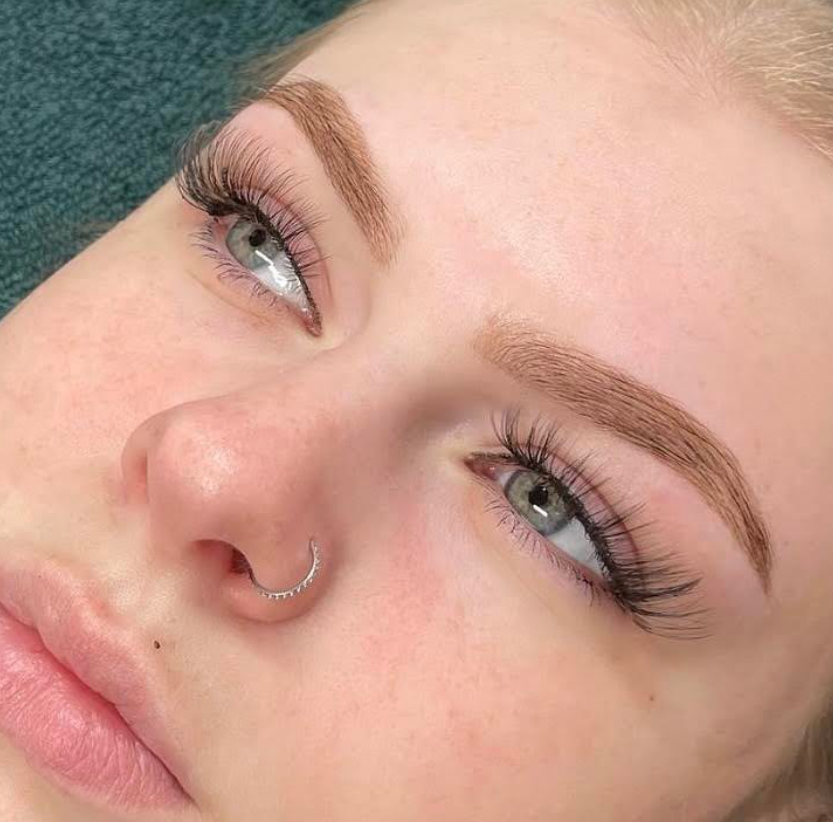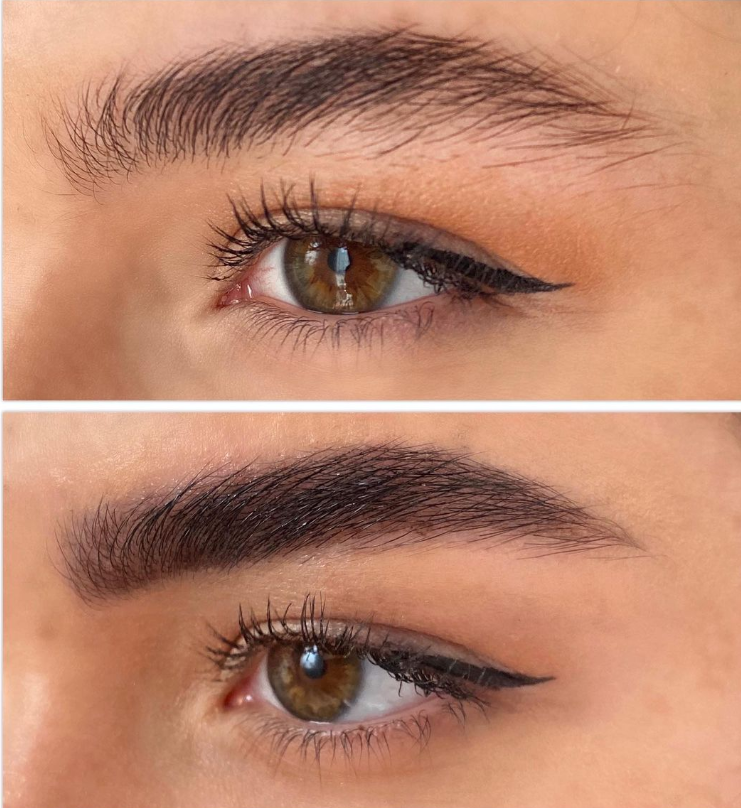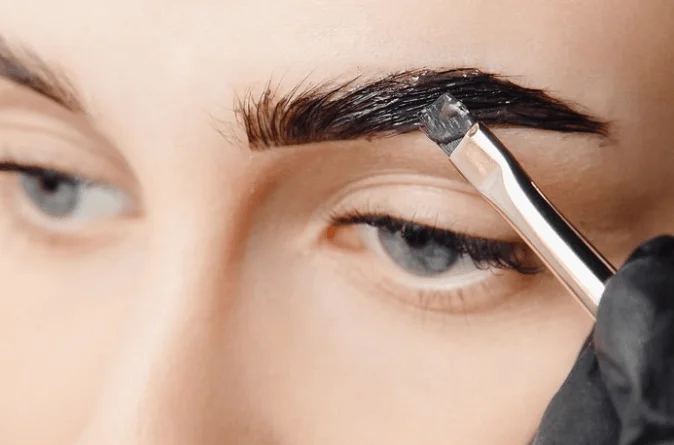Henna brows are a type of eyebrow tinting that uses a natural henna plant dye to temporarily colour the eyebrows. Henna is a plant-based, semi-permanent dye often used to create intricate designs on the skin in various cultures.
Introduction of Henna Brows
Henna brows are a popular beauty treatment that uses a natural dye made from the henna plant to colour and shape the eyebrows temporarily. This semi-permanent dye can last up to 2 weeks and is an excellent alternative to traditional eyebrow tinting, as it provides a more natural and defined look.
Henna is a natural ingredient that is generally safe for use on the skin, making it a popular choice for those looking for a non-toxic and eco-friendly option. However, as with any beauty treatment, it’s essential to do a patch test before henna brows to avoid allergic reactions. Overall, these brows are a great way to enhance the natural beauty of your eyebrows and create a more polished look.
Henna Brows Process
The process of getting henna brows typically involves the following steps:
- Consultation: Your henna brow artist will start with a consultation to understand your desired brow shape and colour. They will also examine your skin type and any previous allergies to ensure the treatment is safe.
- Brow preparation: The artist will thoroughly clean your eyebrows and trim stray hairs to create a neat and tidy shape.
- Henna paste application: The artist will use a spoolie brush to apply the henna paste to your eyebrows hair in the desired shape. The paste will be left to sit for about 10-15 minutes to allow the dye to penetrate the skin and hair.
- Drying and removal: After the henna paste has been set, the artist will gently remove it using a cotton pad or damp cloth. The artist may apply a setting solution to help the colour last longer.
- Aftercare: Your artist will instruct you on how to care for your henna brows, which may include avoiding water contact for 24 hours and refraining from using oil-based products that can cause the colour to fade more quickly.

Henna Brow Aftercare
Proper aftercare ensures that your henna brows last as long as possible and look their best. Check out these useful pointers to maintain your gorgeous henna brows.
- Avoid getting your eyebrows wet for 24 hours after the treatment. You should avoid washing your face, swimming, or sweating excessively after the treatment.
- Do not use oil-based products on your eyebrows, as they can cause the colour to fade faster. Stick to water-based moisturizers and makeup removers.
- Avoid exfoliating your eyebrows for at least a week after the treatment, as it can cause the colour to fade faster.
- Try not to rub or scratch your eyebrows, as this can also cause the colour to fade.
- Avoid direct sunlight and tanning beds, as they can cause the colour to fade faster.
- Contact your henna brow artist immediately if you notice any itching, redness, or swelling around your eyebrows.
- To extend the life of your henna brows, apply a thin layer of coconut or castor oil on them before bed. This can help nourish the hair and skin around the eyebrows and protect the colour.
Henna Brows Pros and Cons
Like any beauty treatment, henna brows have their own set of pros and cons. Here are some of the most commonly cited ones:
Pros:
- Natural-looking results: Henna brows create a natural-looking tint that enhances the existing brows makeup without looking too artificial.
- Semi-permanent: The colour typically lasts up to 2 weeks, longer than traditional eyebrow tinting.
- Customizable: You can mix the henna paste to create a custom colour that matches your skin tone and hair colour.
- Non-toxic: Henna is a natural ingredient that is safe for use on the skin, making it a popular choice for those looking for a non-toxic and eco-friendly option.
Cons:
- Risk of allergic reactions: As with any beauty treatment, there is a risk of allergic reactions, which can cause itching, redness, and swelling around the eyebrows.
- Limited colour options: While henna can be mixed to create custom colours, the range of colours is limited compared to traditional eyebrow tinting.
- Requires professional application: A trained professional needs to apply henna brows to ensure even colour and maximum longevity.
- Temporary results: The colour typically lasts up to 2 weeks, meaning regular touch-ups are necessary to maintain the look.
How Long Does Henna Brows Last
Henna brows typically last two to six weeks, depending on several factors. These include the quality of the henna used, the colour of the henna, the condition of the skin, and the aftercare provided. Generally, the darker the colour of the henna, the longer the henna eyebrows last.
Proper aftercare, such as avoiding getting the brows wet and avoiding exfoliation in the brow area, can help extend the longevity of the henna. Additionally, henna brows may fade more quickly on oilier skin types or with frequent washing or exposure to sunlight.
Henna Brows Cost
The cost of henna brows can vary depending on the brow artist’s location and experience level. Henna brows can cost between $40 to USD 100. The cost may also depend on whether additional services are included, such as brow shaping or tinting. It’s always a good idea to research and compare prices from multiple brow artists in your area to find a price that fits your budget.

Henna Brows vs Microblading
Here are some of the critical differences between the henna brow and microblading:
- Longevity: Microblading typically lasts longer than henna brows, with results lasting up to two years compared to six weeks.
- Commitment: Microblading requires a more significant commitment of time and money than henna brow. The procedure can take up to two hours and may require several touch-up sessions to maintain the desired look.
- Cost: Microblading is typically more expensive than henna brows treatment, ranging from $300 to $800.
- Results: While both henna brow and microblading can produce natural-looking results, microblading may provide a more distinct look.
Henna brows Vs Brow Tint
Henna brows and brow tinting are both popular options for enhancing the appearance of eyebrows. But they differ in a few key ways. Brow tinting involves using a semi-permanent dye to improve the colour and definition of the eyebrow hair. The artist usually allows the dye to sit for 5-10 minutes before wiping it off, resulting in a polished and defined look that can last for up to four weeks.
Here are some of the critical differences between henna brow and brow tinting:
- Ingredients: Henna dye’s natural plant-based composition generally makes it considered safer for use on the skin, particularly for those with sensitive skin. In contrast, brow tinting dye is a chemical-based product.
- Longevity: Henna brow typically lasts longer than brow tinting, with results lasting up to six weeks compared to four weeks.
- Color: Henna dye typically produces a warmer, more natural-looking brow colour than brow tinting dye, which can sometimes create an artificial-looking result.
- Cost: Henna brows are typically more expensive than brow tinting, with costs ranging from $50 to $100 or more, compared to $20 to $40 for brow tinting.

Conclusion
Henna brows are an excellent option for those who want to enhance the appearance of their eyebrows without committing to a long-term solution. The natural henna dye creates a natural-looking tint lasting up to six weeks. However, weighing the pros and cons and considering any potential skin reactions before getting the treatment is crucial.
Learn about bad henna brows here:
FAQ’s
1. Is Henna Safe For Use On The Skin?
Henna is generally considered safe for use on the skin, but some people may have an allergic reaction to it. Doing a patch test before getting henna to create brows is essential to ensure that you do not react.
2. Can I Get Brows Henna If I Have Thin Or Sparse Eyebrows?
Henna brows may not be suitable for those with very thin or sparse brows.
3. Is It Possible To Reapply Henna Tattoos On Eyebrows After They Have Faded?
Henna tattoos on eyebrows are applicable after fading as they are a semi-permanent colouring. However, it’s crucial to wait until the previous henna has fully faded before reapplying to ensure an even application of the new henna color and a more predictable outcome.
